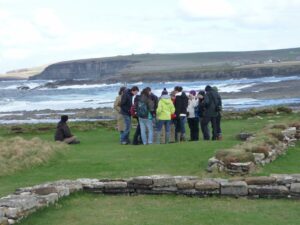
I’ve been spending some time recently with a group of folk who have traveled to Orkney in order to tour the archaeological sites. In this particular case, I’ve had the opportunity (and fun), of guiding the group around Orkney and talking (perhaps too much) about the sites. Of course, one of the highlights was our visit to the Ness of Brodgar in order to see the excavation work taking place and the slow revealing of the site. It got me thinking about our motives for travel and I wondered whether they really differ so much from those of the communities who visited places like the Ness of Brodgar in the past.
In many cases, visitors travel considerable distances to reach Orkney (and my group was no exception). Orkney archaeology has always been popular but as word of the archaeology here has spread around the globe so more and more people arrive. In general, they are keen to experience the sites at first hand, to walk round them, and to learn more about the live-styles of those who originally built and used them. This can be a complex, even daunting, process. The remains that survive from the past look very different to the houses and structures that we are familiar with today and in many ways our lives bear little comparison with those of our ancestors. At first glance one might be forgiven for thinking how boring it all was – there is little colour or noise; everything seems to have comprised drab, silent, shades of stone. It seems very strange, very alien. But of course, it was not really like that at all; we are all people at heart whether we live today or in the past. Human beings have a wonderful facility for personalizing space, for finding colour and for creating sound.
But our connection with the sites that we visit is about more than understanding. It is also about attitude. Modern travel allows us to dip in and out of a range of cultures and landscapes that would have been unthinkable 500 years ago, never mind 5000 years ago. The Internet and Social Media mean that we arrive well prepared with information and, once settled, we can share our experience through images and words with a wide community of friends and acquaintances.
Are we really so very different in this to our prehistoric ancestors? They too, traveled to reach sites like the stone circles, sometimes (like us) journeying a day or more (if by different means) from their home village. They too, got to know strangers, became accustomed to different ways and clothes, tried out new foods, learnt new things, and visited iconic sites. They too had stories to share when they got home. We don’t know what, precisely, went on at the Neolithic stone circles of Orkney, or at sites like Ness of Brodgar; we are fairly certain that the activities involved communal get-togethers. They may have taken place at significant times of the year, they may have involved people from a number of separate villages, some may have travelled considerable distance, and what you came for may have varied in detail depending on specific requirements and times of the year. Or not.
In many cases these journeys seem akin to some sort of pilgrimage: defined by Wikipedia as ‘a journey or search of moral or spiritual significance’. They provided a sense of fulfillment for those who undertook them and helped them to make sense of, and to feel secure in, their world. That is precisely how I see our modern visits to these places. These are powerful locations and many visitors speak of ‘the atmosphere’. Heritage has become a significant asset for the twenty-first century. It helps us to root ourselves in place and community and to feel that we belong and have always belonged. Consider the role of travel and sight-seeing in our society. We love to tick off sites (particularly if included in some sort of list: ‘The 100 Best Sites’; ‘World Heritage’; ‘Remote Places’). We use photos to confirm our presence and validate the ‘specialness’ of the experience. Some like to theme their journeys, whether to sacred sites, Christmas Markets, or wilderness. Others are more eclectic. There is social prestige, and interest, to be gained in becoming a seasoned traveller.
Our horizons may be physically wider than those of our ancestors, but mentally they are little changed. Our technology may be more advanced, but there is little difference in its mental impact. Our trips to the stone circles of Orkney, or anywhere else, rest on the same foundations as those of the prehistoric communities who made similar journeys five thousand years ago. When I’m at the Ring of Brodgar, or exploring the Stones of Stenness, I share a purpose with those who were there in the past. I’m validating the place of the monument in the world of today: my world. That is what my recent guests were doing. And that, I feel, is exactly what my prehistoric forebears were doing.
You must be logged in to post a comment.